Human Flower Project
Apple Day
John Levett tastes tastes, names names. Old varieties like Ribston Pippin recall when the city and the country were more clearly connected. They lead forward, too, in the movement to save England’s allotments.
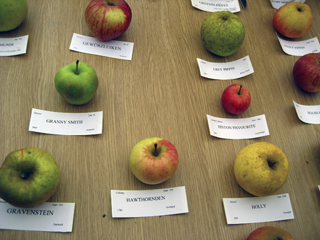
Story & Photos by .(JavaScript must be enabled to view this email address)
Some years ago BBC Radio 5 ran a Doris Day in celebration of Dorises everywhere. They even managed to get a phone link to the iconic pre-feminist post-ironic Doris of Doris & Rock fame. Doris Day (we’re back to the ‘day’ now) was, of course, a take on the variety of ‘days’ that any feeling-neglected-getting-no-attention-need-awareness cell announces to a no-notice-taken-shout-louder public.
It’s often seriously worthy groups dealing with frequently-unmentionable-and-I’d-rather-you-didn’t inner and outer bodily bits that feel left out of the giving & taking joys of such as Christmas, Easter, Halloween, the essential remembrances of Armistice Day and the vapid creations of The-Day-Diana-Died banality. Then come varieties of tree huggers, save-the stoaters, wear-a-kilt-for healthers, stop-nail-biting-in-under-fivers; to name none that I’ve heard of but am convinced they’ve had a day to themselves.
Apple Day is one such day—made up by old apple growers of old apples and confined, as far as I can tell, to Cambridge. It seems it’s been going for eleven years, attracts queues, sells out its stock of everything apple-related (ciders, juices, toddies, pies, cakes, jams, chutneys, honeys hived in apple orchards), identifies your apples, gives apple history lectures, warns of pests and sells you forty varieties of eaters and cookers. And (inevitably & predictably) there are ‘apple art activities’ for families (kids can’t go anywhere these days without having to draw something; what happened to clambering over stuff and carving your name on it?)
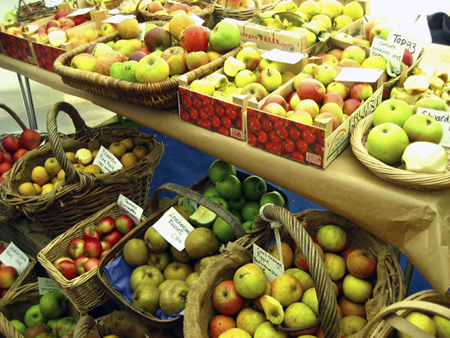
It’s housed (or should that be ‘tented’?) at the Cambridge Botanic Garden & sponsored (essential to get global monopoly capitalism behind you these days) by Waitrose. Actually I can understand Waitrose’s participation in this. I haven’t checked out yet how many of these varieties the up-market retailers stock themselves but I’d guess they do a few; here in Cambridge I’m convinced Waitrose match your food to your style of clothing (“We have a very nice cut of Aberdeen steak, madam. It matches your autumnal twin-piece perfectly. Our veal goes with the ear-rings too.”)
A friend phoned me up & asked “Wanna go?” so we did. Autumn this year has been stunning. It seems it has something to do with the washed-out Summer and the extraordinary creation of sugars in the trees, which is no consolation to the flood sufferers but it does make the best out of Cambridge. Sunday was cloudless, the Garden was only a walk away but friend has convertible so we drove and sat in traffic and gas-guzzled. (“Heat that planet up and we can have our very own Cambridge Pineapple Day for the grandkids,” I say.)
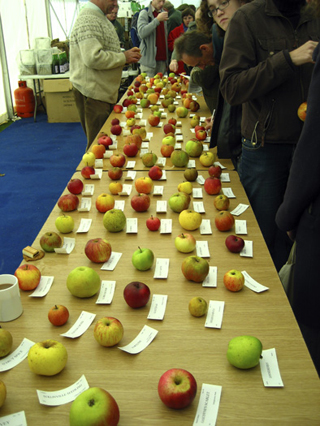 The first thing that struck me was the queues outside the tasting tents. Vast! Is queuing an Anglo-Saxon thing? I can remember queuing to get into a glass foundry on the island of Majorca once when a bus load of Italians fell out the bus and trooped in disorderly non-file straight through into the workshop. Quelle horreur! Bounders ought to be shackled!
The first thing that struck me was the queues outside the tasting tents. Vast! Is queuing an Anglo-Saxon thing? I can remember queuing to get into a glass foundry on the island of Majorca once when a bus load of Italians fell out the bus and trooped in disorderly non-file straight through into the workshop. Quelle horreur! Bounders ought to be shackled!
So, Italian style, we walked to the exit and started there. It was like being a kid again in a sweetshop. Truth to tell, I’ve never been a great apple fan. When I was growing up there was an orchard (bombed but trees still standing) at the top of our plot; great for cricket, camping and playing at failing to hang ourselves (I kid you not!) And pigging out on apples. I went over to bananas which, being just after the last war, still had rarity value. Gradually apples went out of my life, supermarkets came in, taste never came back.
Apple Day changed that. If I’d ever remembered, I’d forgotten what an apple could taste like. I tasted all forty & went back (that would be ‘backwards’ having come in through the exit) to check the taste again. Then bought some. I went for the names knowing that the variety wouldn’t disappoint. Here’re some: Zabergäu Reinette (Germany 1885), Orleans Reinette (France 1776), Ribston Pippin (UK 1707), Rosemary Russet (UK 1831), Crispin (Japan 1930), Belle de BosKoop (Netherlands 1856).
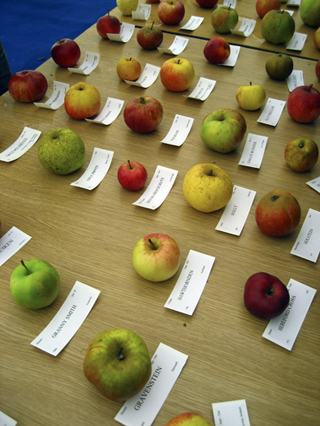 Even the crosses sound wonderful: Charles Ross (Cox’s Orange Pippin x Peasgood Nonsuch), Gloster (Richared Delicious x Weisser Winterglockenapf). Then the cookers: Lane’s Prince Albert (1841 Russet Nonpareil x Dumelow’s Seedling), Ontario (1820 Wagener x Northern Spy), Striped Beefing (1794 from Lakenham in Norfolk).
Even the crosses sound wonderful: Charles Ross (Cox’s Orange Pippin x Peasgood Nonsuch), Gloster (Richared Delicious x Weisser Winterglockenapf). Then the cookers: Lane’s Prince Albert (1841 Russet Nonpareil x Dumelow’s Seedling), Ontario (1820 Wagener x Northern Spy), Striped Beefing (1794 from Lakenham in Norfolk).
What took me so much was that each variety had a history; came from a place, had a birthday, knew its mother and father, appeared at some time in a nurseryman’s catalogue. Here’s Ribston Pippin raised from a pip brought from Rouen to Ribston in Yorkshire in 1707. I can appreciate that, being a rose grower. I like to know where my roses were raised, something about the rose grower, which crosses brought forth seed, which unlikely parents worked the trick. If Jack Harkness hadn’t done his apprenticeship at J. Burrell & Co. just outside Cambridge about 1930 and learnt hybridizing from Edward Doncaster, I’d never have had Doncasterii in my garden; it’s placing it in history that matters.
This next paragraph is pretty predictable but I’ll do it anyway. I can walk into Asda and pick up a (plastic) bag of Cox’s Orange for a quid; plastic bag because Cox’s would never grow uniformly to fit into a uniform. Golden Delicious do; so they’re beloved of supermarkets. Braeburn fit the same moulded nests. Cox’s have blemishes. GD’s don’t. Cox’s don’t taste quite the same this month as they did last. GD’s do. There was a tale told some time ago that the only country that eats Golden Delicious by the truck load is the UK; stacked up port-side in Calais waiting for the day trippers. I despair. Same goes for tomatoes, potatoes, onions and shallots, pretty much any veg—no acknowledged begetter.
My mother ran a small grocer’s shop when I was growing up and everything had a name—potatoes were King Edwards, tomatoes were Cheshunt Tangellas, onions were Bedfordshire Champions. And from the name you knew when they’d been dug, when picked, when planted and the name of the farm, the name of the nursery, was on the sack, on the box and, as likely as not, they were local. Even living in the city there was some country connection. London’s East End families taking two weeks each year hop-picking in Kent most easily comes to mind (read Orwell’s ‘A Clergyman’s Daughter’) and, living in South London in the mid ‘60s, there was still spending money to be got from fruit picking on the Weald.
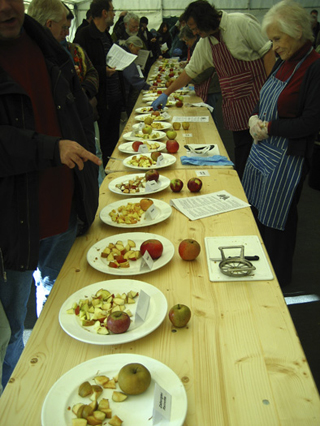 Allotments are coming back into fashion. There was a danger some decade or more ago that town and city plots were likely to be swallowed by residential development so neglected and abandoned had many of them become. The rise of the organic food trade, the fuss over GM technology, the blandness of supermarket produce, the downturn of taste in readily available fruit and veg & the recognition that a valuable public resource was likely to be lost for ever from our culture translated into a (mostly middle class but not to be deprecated for that!) upsurge in interest & uptake of rented municipal plots.
Allotments are coming back into fashion. There was a danger some decade or more ago that town and city plots were likely to be swallowed by residential development so neglected and abandoned had many of them become. The rise of the organic food trade, the fuss over GM technology, the blandness of supermarket produce, the downturn of taste in readily available fruit and veg & the recognition that a valuable public resource was likely to be lost for ever from our culture translated into a (mostly middle class but not to be deprecated for that!) upsurge in interest & uptake of rented municipal plots.
I can remember renting two plots in the early ‘70s for about £5 each and got seeds and sets from the local allotment association at cost. I also got community. Even then, when Tesco was only at the early stages of mustering its troops, there was something radical about growing your own stuff and that mindset is within the current movement back to allotments. They arose out of the Enclosure and Commons Acts of the Nineteenth Century and the subsequent loss of working class cultivation land (how else to drive them into the factories?) There was a high of a million and a half plots during the last war down to a quarter million by the millennium. The news that the 2012 Olympics would bulldoze some local communal land holdings brought the allotment issue back to the fore. We know what we can lose here.
The average cost of an allotment (250 square metres…think two and a half lanes of a 100m track) in Cambridge is £20 a year. Then think variety, taste, companionship, digestion, exercise, wildlife, conversation, sharing, history, recipes, snacks, soups, roasts, seed catalogues, harvest, summer, timelessness, early morning, sunset, sandwiches, chutney, an apple tree.
It’s not only fruit and veg. I used to grow sweet peas on the plots I had thirty years ago from seed I got every September from Bolton’s near Haverhill in Essex. Twenty varieties each year. Bolton’s have long gone but there are plenty of nurseries who keep the old varieties in their lists. Delphiniums grew there too; sow-‘em-and-see varieties from the Delphinium Society (whose seed list came this week).
It’s something that passed out of my life and high time that it passed back in. I’ve just glanced at Chiltern Seeds’ catalogue—twenty-eight varieties of bean, twenty-three basil, huauzontle and jicama, couve tronchuda, kiwano, miner’s lettuce, scorzonera, vegetable spaghetti. Get some!
Comments
Thank you John Levitt. This article makes me want to cry, I grew up and shopped as a young woman for seasonal vegetables and fruits including apples. We used to get Worchester Pippens for maybe three weeks – crisp, delicious, juicy but not keepers, and later Russets also distinctively delicious, and at Christmas Coxes Orange Pippens often slightly wizened and the more delectable for it.
As you say potatoes were named and therefore you knew how best to cook them – roast, mashed, boiled, chipped.
Here I am now lucky enough to buy named veggies and fruits from the farmer’s market, a fairly wide range of veggies as the growers are Europeans, but nobody here even knows about cooking apples (or cider apples), so making a decent baked apple is a memory of the past.
Any chance of a larger image of the apples in rows with their name tags? Two along and one up from the granny smith is a large green apple with lacy copper/gold mottling on the skin. This looks a lot like the 50 year old tree of cookers I have in the back yard. I’d love to be able to read the name tag. I must have made hundreds of apple cakes from that tree!
Dear Tessa,
I think this is Grey Pippin. Will email you the photo—and you can contact John too – his email is hotlinked at the top of the story.
Great to hear from you!
J.


Apple Day is a national event in England organised by Common Ground – and is 18 years old this year.
I’m so pleased you discovered the event in Cambridge and enjoyed tasting the diversity of apples.
All the events are listed here http://www.commonground.org.uk/appleday/a-events.html
All the best
Celia